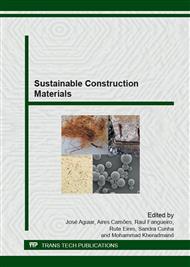[1]
GONÇALVES, J.P.; TAVARES, L.M., TOLEDO FILHO, R. D; FAIRBAIRN, E.M.R., CUNHA, E.R. Comparison of natural and manufactured fine aggregates in cement mortars. Cement and Concrete Research, V. 37, 2007; 924–932.
DOI: 10.1016/j.cemconres.2007.03.009
Google Scholar
[2]
JALALI, S.; PACHECO-TORGAL, F.; DING, Y. Properties and durability of concrete containing polymeric wastes (tire rubber and polyethylene terephtalate bottles): an overview. Construction and Building Materials, V. 30, 2012; 714 – 724.
DOI: 10.1016/j.conbuildmat.2011.11.047
Google Scholar
[3]
MANSUR, A.A.P., NASCIMENTO, O.L.; MANRIR, H.S. Physicochemical characterization of EVA-modified Mortar and porcelain tiles interfaces Original Research Article Cement and Concrete Research, Volume 39, Issue 12, December 2009, Pages 1199-1208.
DOI: 10.1016/j.cemconres.2009.07.020
Google Scholar
[4]
MESSAN, A; LENNY, P.; NECTOUX, D. Free and restrained early-age shrinkage of mortar: Influence of glass fiber, cellulose ether and EVA (ethylene-vinyl acetate) Original Research Article Cement and Concrete Composites, Volume 33, Issue 3, March 2011, Pages 402-410.
DOI: 10.1016/j.cemconcomp.2010.10.019
Google Scholar
[5]
SILVA, D.A., ROMAN, H.R., GLEIZE, P.J.P. Evidences of chemical interaction between EVA and hydrating Portland cement Original Research Article Cement and Concrete Research, Volume 32, Issue 9, September 2002, Pages 1383-1390.
DOI: 10.1016/s0008-8846(02)00805-0
Google Scholar
[6]
AKCAOZOGLU, S., ATIS, C.D., AKCAOZOGLU, K. An investigation on the use of shredded pet waste bottles as aggregate in lightweight concrete. Waste Management, 2010; 32: 285–90.
DOI: 10.1016/j.wasman.2009.09.033
Google Scholar
[7]
CHOI, Y.W., MOON, D.J., CHUNG, J.S., CHO, S.K. Effects of pet waste bottles aggregate on the properties of concrete. Cement and Concrete Research, 2005; 35: 776–81.
DOI: 10.1016/j.cemconres.2004.05.014
Google Scholar
[8]
HANNAWI, K.; KAMALI-BERNARD, S.; PRINCE, W. Physical and mechanical properties of mortars containing PET and PC waste aggregates. Waste Management, 2010; 30: 2312–20.
DOI: 10.1016/j.wasman.2010.03.028
Google Scholar
[9]
SAFI, B.; SAIDI, M.; ABOUTALEB, D.; MAALEM, M. The use of plastic waste as fine aggregate in the self-compacting mortars: Effect on physical and mechanical properties. Construction and Building Materials. V. 43, 2013; 436–442.
DOI: 10.1016/j.conbuildmat.2013.02.049
Google Scholar
[10]
FRAJ, A.B.; KISMI, M.; MOUNANGA, P. Valorization of coarse rigid polyurethane foam waste in lightweight aggregate concrete. Construction and Building Materials, V. 24, 2010; 1069-77.
DOI: 10.1016/j.conbuildmat.2009.11.010
Google Scholar
[11]
MOUNANGA, P.; GBONGBON, W.; POULLAIN, P.; TURCRY, P. Proportioning and characterization of lightweight concrete mixtures made with rigid polyurethane foam wastes. Cement and Concrete Composites, V. 30, 2008; 806–14.
DOI: 10.1016/j.cemconcomp.2008.06.007
Google Scholar
[12]
JUNCO, C.; GADEA, J.; RODRIGUEZ, A.; GUTIÉRREZ-GONZÁLES, S.; CALDERÓN, V. Durability of lightweight masonry mortars made with white recycled polyurethane foam Original Research Article Cement and Concrete Composites, Volume 34, Issue 10, November 2012, Pages 1174-1179.
DOI: 10.1016/j.cemconcomp.2012.07.006
Google Scholar
[13]
GADEA, J.; RODRÍGUEZ, A.; CAMPOS, P.L.; GARABITO, J.; CALDERÓN, V. Lightweight mortar made with recycled polyurethane foam Original Research Article. Cement and Concrete Composites, Volume 32, Issue 9, October 2010, Pages 672-677.
DOI: 10.1016/j.cemconcomp.2010.07.017
Google Scholar
[14]
MOUNANGA, P.; GBONGBON, W.; POULLAIN, P.; TURCRY, P. Proportioning and characterization of lightweight concrete mixtures made with rigid polyurethane foam wastes. Original Research Article. Cement and Concrete Composites, Volume 30, Issue 9, October 2008, Pages 806-814.
DOI: 10.1016/j.cemconcomp.2008.06.007
Google Scholar
[15]
KOU, S.C.; LEE, G.; POON, C.S.; LAI, W.L. Properties of lightweight aggregate concrete prepared with PVC granules derived from scraped PVC pipes. Waste Management, 2009; 29: 621–8.
DOI: 10.1016/j.wasman.2008.06.014
Google Scholar
[16]
WANG, R.; MEYER, C. Performance of cement mortar made with recycled high impact polystyrene. Cement & Concrete Composites. V. 34, 2012; 975–981.
DOI: 10.1016/j.cemconcomp.2012.06.014
Google Scholar
[17]
KAN, A.; DEMIRBOGA, R. A novel material for lightweight concrete production. Cement & Concrete Composites, 2009; 31: 489–95.
DOI: 10.1016/j.cemconcomp.2009.05.002
Google Scholar
[18]
KAN, A.; DEMIRBOGA, R. A new technique of processing for waste-expanded polystyrene foams as aggregates. Journal of Materials Processing Technology, V. 209, 2009; 2994–3000.
DOI: 10.1016/j.jmatprotec.2008.07.017
Google Scholar
[19]
SCHACKOW, A.; EFFTING, C.; FOLGUERAS, M.V.; GÜTHS, S.; MENDES, G.A. Mechanical and thermal properties of lightweight concretes with vermiculite and EPS using air-entraining agent Original Research Article. Construction and Building Materials, Volume 57, 30 April 2014, Pages 190-197.
DOI: 10.1016/j.conbuildmat.2014.02.009
Google Scholar
[20]
SAIKIA, N.; BRITO, J. Use of plastic waste as aggregate in cement mortar and concrete preparation: A review. Construction and Building Materials, V. 34, 2012; 385–401.
DOI: 10.1016/j.conbuildmat.2012.02.066
Google Scholar
[21]
TREIN, F.A.; VARGAS, A.S.; RODRIGUES, M.A.S.; GOMES, J.P.C. Evaluation of the Influence of PU/EVA Waste-Based Lightweight Aggregates on the Physical Properties of Alkali-Activated Mortars. Luso-Brazilian Conference on Sustainable Construction Materials CLB-MCS. Guimarães, Portugal. (2014).
DOI: 10.4028/www.scientific.net/kem.634.278
Google Scholar
[22]
BRAZILIAN ASSOCIATION OF TECHNICAL STANDARDS (ABNT). Regulatory Standard NBR 9935: Aggregates - terminology. Rio de Janeiro, (2011).
Google Scholar
[23]
BRAZILIAN ASSOCIATION OF TECHNICAL STANDARDS (ABNT). Regulatory Standard NBR 7215: Portland cement – Determination of compressive strength, Rio de Janeiro, (1996).
Google Scholar
[24]
BARBOSA, V. F. F. Synthesis and characterization of geopolymers. Rio de Janeiro, 1999. 199 p. Thesis (PhD in Engineering) - Department of Materials Science, Military Institute of Engineering (IME).
Google Scholar
[25]
BRAZILIAN ASSOCIATION OF TECHNICAL STANDARDS (ABNT). Regulatory Standard NBR 10005: Procedure for obtaining leaching extract from solid wastes. Rio de Janeiro, 2004b.
Google Scholar
[26]
BRAZILIAN ASSOCIATION OF TECHNICAL STANDARDS (ABNT). Regulatory Standard NBR 10006: 2004 Procedure for obtaining solubilized extract from solid wastes Rio de Janeiro, 2004b.
Google Scholar
[27]
BRAZILIAN ASSOCIATION OF TECHNICAL STANDARDS (ABNT). Regulatory Standard NBR 10004: Solid waste - Classification. Rio de Janeiro, (2004).
Google Scholar


